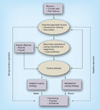Understanding why cognitive-behavioral therapy is an effective treatment for adolescents with juvenile fibromyalgia
- PMID: 24416078
- PMCID: PMC3885254
- DOI: 10.2217/IJR.13.3
Understanding why cognitive-behavioral therapy is an effective treatment for adolescents with juvenile fibromyalgia
Abstract
Recent studies have demonstrated that cognitive-behavioral therapy (CBT) is an effective treatment for children and adolescents with juvenile fibromyalgia. Unfortunately, the specific psychological changes that occur during treatment that explain why CBT works are not well understood. Historically, the increased use of specific coping strategies learned during CBT was thought to be the primary reason for why CBT was effective. However, evidence to support the notion that increases in adaptive coping directly lead to patient improvement is minimal. Instead, a growing number of studies in adults suggest that CBT results in more global changes of psychological perceptions of the pain itself (cognitive appraisals) and one's ability to manage the pain. This report discusses the role of coping and aspects of cognitive appraisal as potential psychological changes that explain CBT-related improvements for youths with juvenile fibromyalgia.
Keywords: adaptive coping; catastrophic thinking; chronic pain; cognitive appraisal; cognitive–behavioral therapy; coping self-efficacy; juvenile fibromyalgia.
Conflict of interest statement
The authors have no other relevant affiliations or financial involvement with any organization or entity with a financial interest in or financial conflict with the subject matter or materials discussed in the manuscript apart from those disclosed.
No writing assistance was utilized in the production of this manuscript.
Figures
Similar articles
-
Identifying treatment responders and predictors of improvement after cognitive-behavioral therapy for juvenile fibromyalgia.Pain. 2014 Jul;155(7):1206-1212. doi: 10.1016/j.pain.2014.03.005. Epub 2014 Mar 17. Pain. 2014. PMID: 24650858 Free PMC article. Clinical Trial.
-
Changes in pain coping, catastrophizing, and coping efficacy after cognitive-behavioral therapy in children and adolescents with juvenile fibromyalgia.J Pain. 2013 May;14(5):492-501. doi: 10.1016/j.jpain.2012.12.019. Epub 2013 Mar 26. J Pain. 2013. PMID: 23541069 Free PMC article.
-
Pilot Randomized Trial of Integrated Cognitive-Behavioral Therapy and Neuromuscular Training for Juvenile Fibromyalgia: The FIT Teens Program.J Pain. 2018 Sep;19(9):1049-1062. doi: 10.1016/j.jpain.2018.04.003. Epub 2018 Apr 17. J Pain. 2018. PMID: 29678563 Free PMC article. Clinical Trial.
-
Cognitive behavioral therapy for fibromyalgia.Nat Clin Pract Rheumatol. 2006 Aug;2(8):416-24. doi: 10.1038/ncprheum0245. Nat Clin Pract Rheumatol. 2006. PMID: 16932733 Review.
-
Nonsomatic treatment of depression.Child Adolesc Psychiatr Clin N Am. 2002 Jul;11(3):579-93. doi: 10.1016/s1056-4993(02)00009-3. Child Adolesc Psychiatr Clin N Am. 2002. PMID: 12222084 Review.
Cited by
-
Mindfulness-Based Stress Reduction for Adolescents with Functional Somatic Syndromes: A Pilot Cohort Study.J Pediatr. 2017 Apr;183:184-190. doi: 10.1016/j.jpeds.2016.12.053. Epub 2017 Jan 12. J Pediatr. 2017. PMID: 28088398 Free PMC article.
-
Juvenile primary fibromyalgia syndrome: A Review- Treatment and Prognosis.Pediatr Rheumatol Online J. 2021 May 18;19(1):74. doi: 10.1186/s12969-021-00529-x. Pediatr Rheumatol Online J. 2021. PMID: 34006290 Free PMC article. Review.
-
Pain catastrophizing in children with chronic pain and their parents: proposed clinical reference points and reexamination of the Pain Catastrophizing Scale measure.Pain. 2014 Nov;155(11):2360-7. doi: 10.1016/j.pain.2014.08.035. Epub 2014 Aug 29. Pain. 2014. PMID: 25180013 Free PMC article.
-
Identifying treatment responders and predictors of improvement after cognitive-behavioral therapy for juvenile fibromyalgia.Pain. 2014 Jul;155(7):1206-1212. doi: 10.1016/j.pain.2014.03.005. Epub 2014 Mar 17. Pain. 2014. PMID: 24650858 Free PMC article. Clinical Trial.
-
Fibromyalgia: Treating Pain in the Juvenile Patient.Paediatr Drugs. 2017 Aug;19(4):325-338. doi: 10.1007/s40272-017-0233-5. Paediatr Drugs. 2017. PMID: 28536810 Free PMC article. Review.
References
-
- Bernardy K, Fuber N, Kollner V, Hauser W. Efficacy of cognitive-behavioral therapies in fibromyalgia syndrome – a systematic review and metaanalysis of randomized controlled trials. J. Rheumatol. 2010;37(10):1991–2005. - PubMed
-
- Glombiewski JA, Sawyer AT, Gutermann J, Koenig K, Rief W, Hofmann SG. Psychological treatments for fibromyalgia: a meta-analysis. Pain. 2010;151(2):280–295. - PubMed
-
-
Kashikar-Zuck S, Ting TV, Arnold LM, et al. Cognitive behavioral therapy for the treatment of juvenile fibromyalgia: a multiske single-blind randomized controlled clinical trial. Arthritis Rheum. 2012;64(1):297–305. ▪▪ Randomized controlled trial demonstrating the efficacy of cognitive-behavioral therapy for youths with juvenile fibromyalgia.
-
-
- Kashikar-Zuck S, Swain NF, Jones BA, Graham TB. Efficacy of cognitive-behavioral intervention for juvenile primary fibromyalgia syndrome. J. Rheumatol. 2005;32(8):1594–1602. - PubMed
-
- Degotardi PJ, Klass ES, Rosenberg BS, Fox DG, Gallelli KA, Gottlieb BS. Development evaluation of a cognitive-behavioral intervention for juvenile fibromyalgia. J. Pediatric Psychol. 2006;31(7):714–723. - PubMed
Grants and funding
LinkOut - more resources
Full Text Sources
Other Literature Sources

